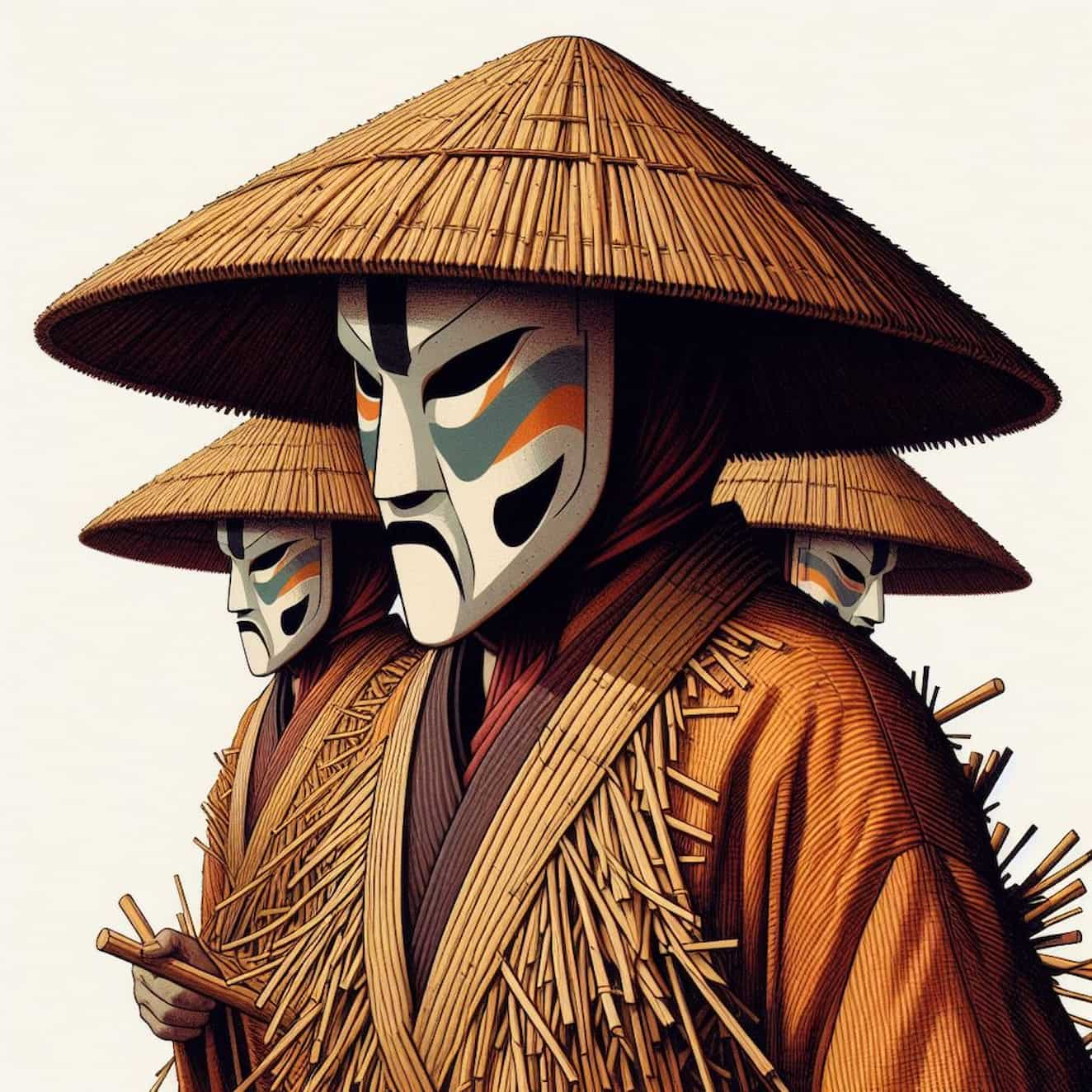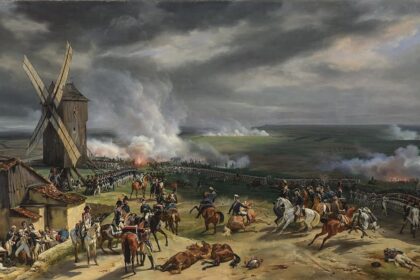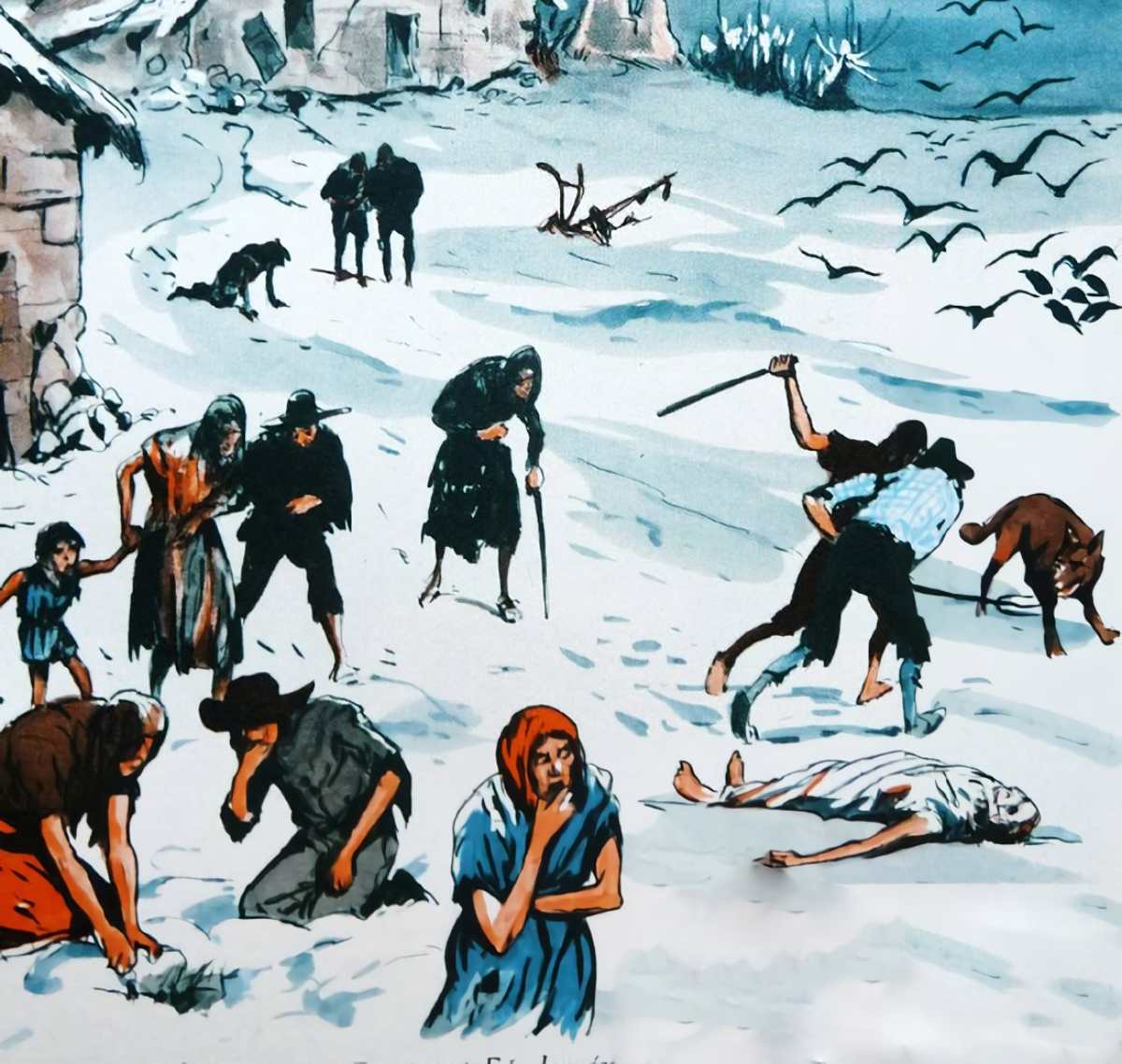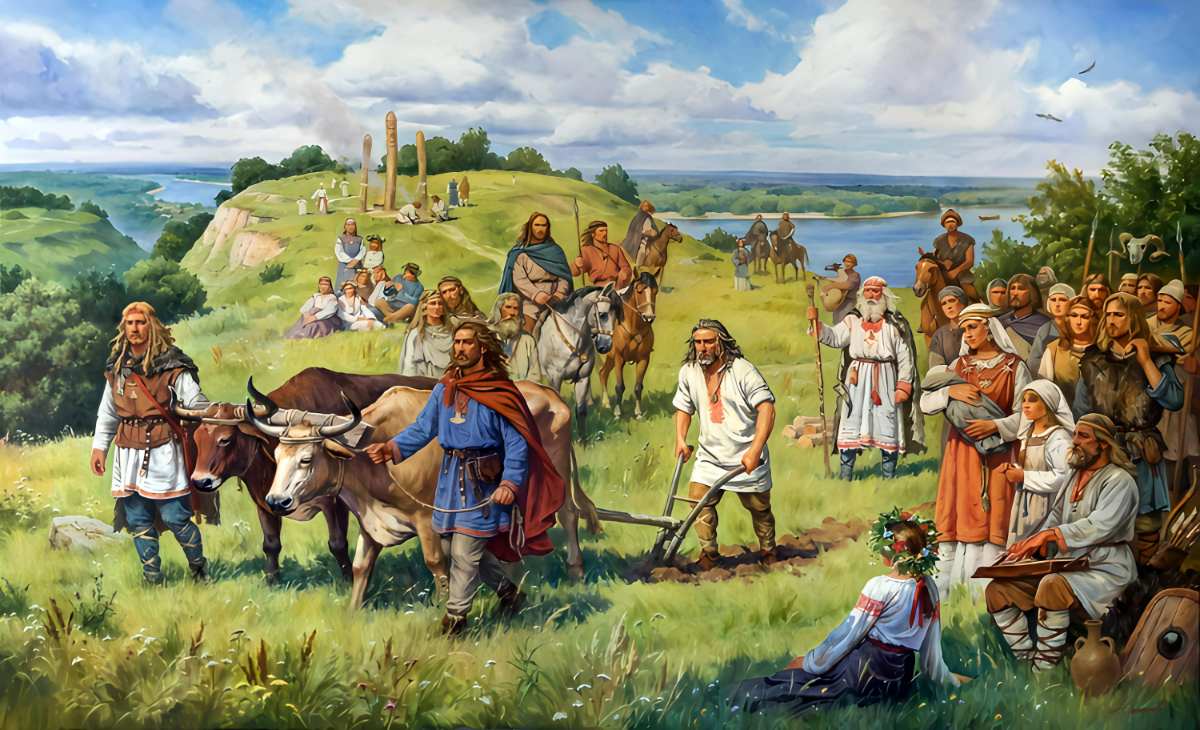Namahage refers to the masked and straw-clothed messengers of the gods (visiting gods) who have been part of year-round events in and around the Oga Peninsula in Akita Prefecture.
Overview
Namahage is a traditional folk event found on the Oga Peninsula in Akita Prefecture (Oga City), as well as in some parts of its base (Mitsushima Town in Yamamoto District and Katagami City). It has a history of over 200 years. According to surveys conducted in places like Oga City, from 2012 to 2015, Namahage events were held in about 80 out of 148 districts in the city. Designated as an Important Intangible Folk Cultural Property of the country as “Namahage of Oga” and registered as one of the “Visiting Gods: Masked and Costumed Gods” on UNESCO’s Intangible Cultural Heritage list. The “Namahage,” wearing peculiar masks and costumes made of straw, visit households to drive away evil spirits or admonish lazy people.
At the Shinzan Shrine in Oga City, the appearance of Namahage is considered a ritual called the Namahage Shibata Festival.
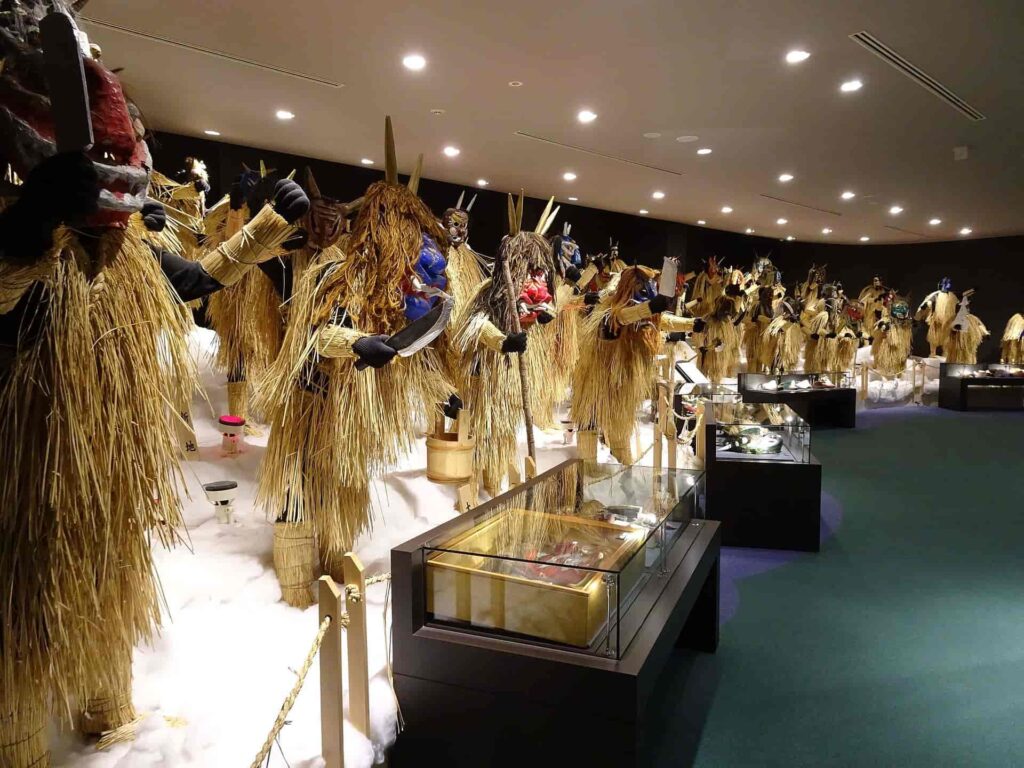
Similar events to Namahage are widely distributed throughout Japan. Among them, Namahage, in particular, has gained overwhelming popularity, becoming a symbol of Akita Prefecture. Due to its significant appeal, Namahage is not only used for tourism PR in Akita Prefecture but also serves as a motif for private companies related to Akita Prefecture, as well as being used frequently as an ornament or entertainment at merchandise and food and beverage stores related to Akita Prefecture.
Earlier Timing of the Event
During the Edo period, it was held on January 15th, the Little New Year of the lunar calendar, but with the calendar reform in the Meiji era, examples of holding it a month earlier, on January 15th of the Gregorian calendar, have also been seen.
After World War II, it was further moved about two weeks earlier to December 31st of the Gregorian calendar. Note that the lunar New Year’s Eve is December 30th or 29th.
Decline of Traditional Customs and Countermeasures
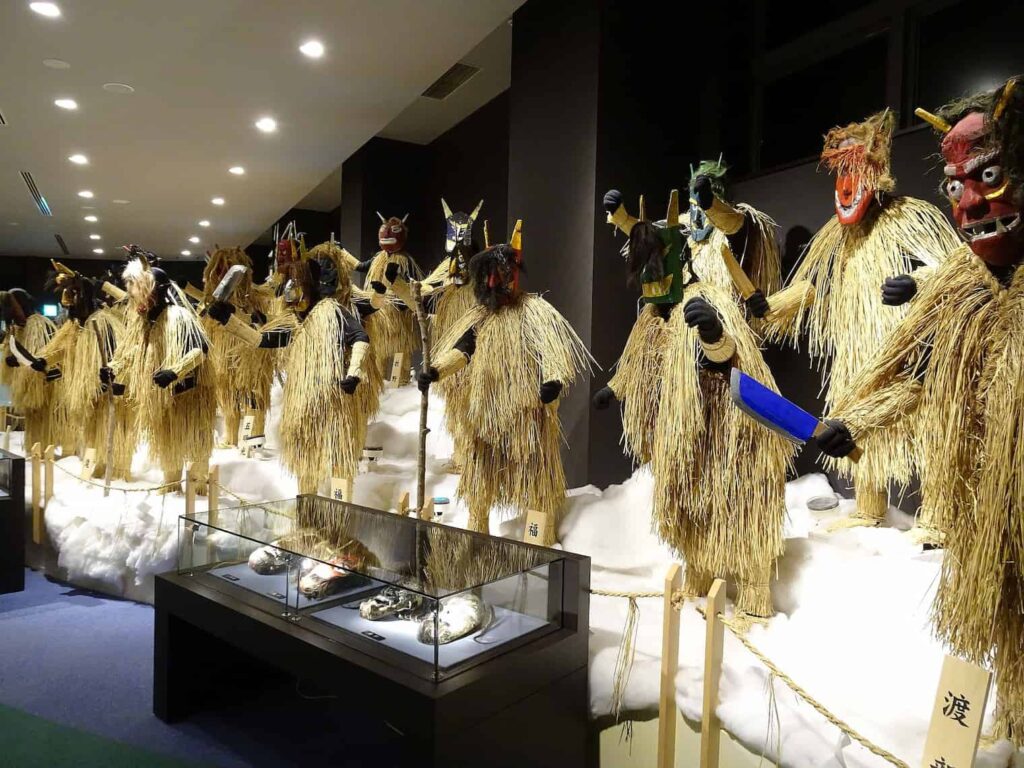
Communities that conduct Namahage as a year-round event for visiting households used to be prevalent throughout the Oga Peninsula, but due to the aging population and declining birth rates, they have now almost halved. According to surveys in Oga City, about 35 districts discontinued the event in the 25 years until 2015.
Originally, unmarried men from the community would act as Namahage, but with the aging population and declining population of the community, the number of young people taking on this role has decreased. Additionally, there are now cases of outsiders, such as relatives visiting from outside the community, taking on the role. In the Sugoroku district of Oga City, foreign exchange students from Akita University and the International University of Japan have also taken on the role of Namahage. Furthermore, as households with children, the primary targets of Namahage visits, decrease due to declining birth rates, there is a decline in motivation to carry out the event. Other factors contributing to the decline of Namahage include changes in residents’ lifestyles, such as having work or being absent due to travel during the New Year holidays. Namahage can even be performed by high school students.
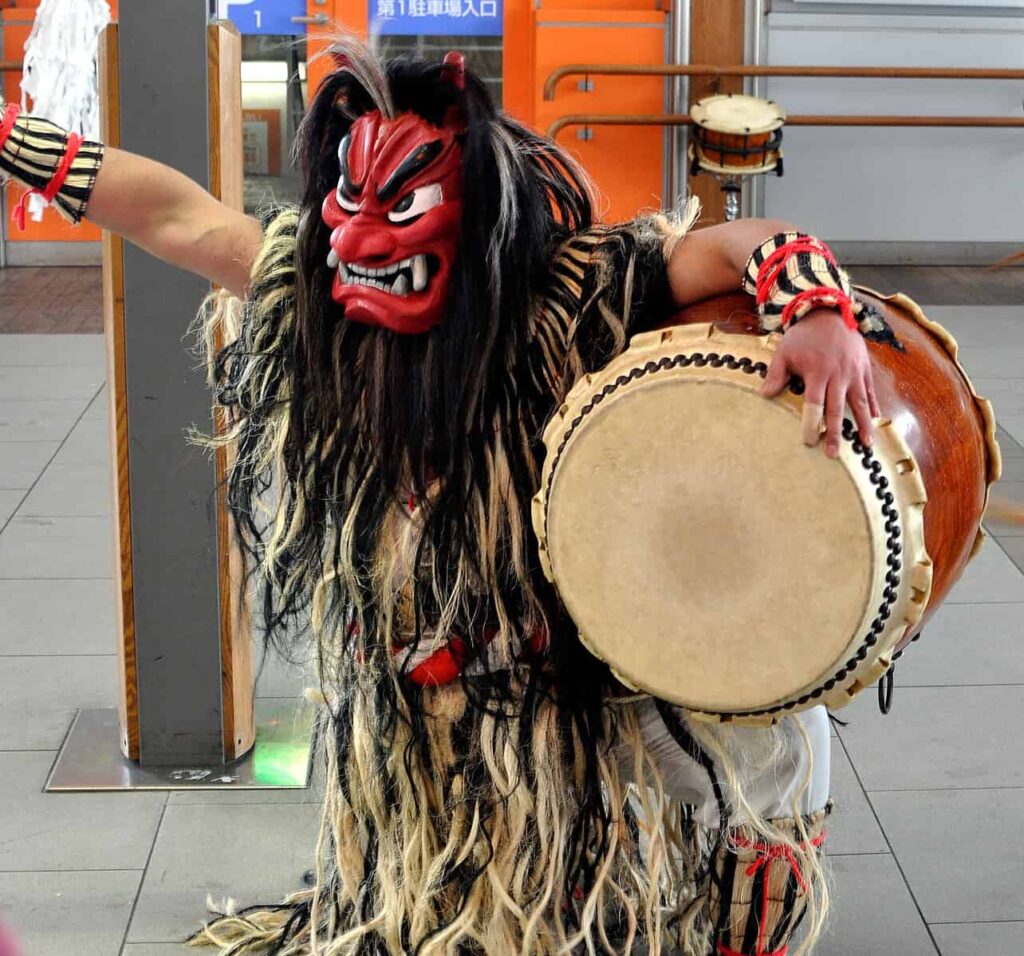
As a countermeasure, since the fiscal year 2012, Oga City has been providing subsidies to neighborhood associations that conduct Namahage events. However, of the 148 neighborhood associations in the city in that year, only six resumed Namahage events, while nearly half, 71 associations, did not. This trend continued in the fiscal year 2015, with 69 associations not implementing the event.
In the Hana-date station area of Oga City, there was consideration given to women dressing up as Namahage on New Year’s Eve in 2018, but this idea was shelved.
“Tourism” Development
On the Oga Peninsula, there is a facility called the “Oga Shinzan Tradition Hall” where visitors can experience Namahage year-round for tourism purposes. Additionally, beyond just the Oga region, Namahage is utilized in Akita Prefecture’s tourism and product PR activities, and statues are installed not only permanently but also temporarily in various places, becoming a symbol of Akita Prefecture. In districts where there is a tradition that Namahage are unmarried men, it is common for married men from those districts to dress up as Namahage for tourist events.
New entertainments featuring Namahage as a motif have also been created to entertain tourists. During the leisure boom period, centered around group tours, seen during the high economic growth period of the Showa era, there was the “Namahage Dance,” and during the resort boom period at the beginning of the Heisei era, there was the “Namahage Drum.” These performances extend beyond seasonal and regional boundaries, participating not only in events such as the Akita Kanto Festival but also in various product exhibitions, and they even have solo performances. Unlike traditional Namahage, these performances involve wearing masks resembling demons and costumes made not of straw but of durable materials like yarn or hemp rope.
In rural-style restaurants and eateries, folk entertainment props are used for interior decoration, and employees perform folk entertainment to attract customers and increase satisfaction. In eateries featuring Akita Prefecture’s local cuisine and specialty products following this business model, it is common to use Namahage masks for interior decoration and for male and female employees to perform “Namahage Shows” year-round according to the store’s schedule, a practice frequently seen not only in the Oga region but also in and outside Akita Prefecture.
“Transformation into Oni”
Because Namahage have horns, they are sometimes mistaken for oni (ogres), but they are not. Originally, Namahage were gods of visitation unrelated to oni, but during the process of modernization, they became confused with oni and were mistakenly incorporated as a type of oni, leading to a transformation that could not be clarified. There is a theory that suggests this. Works of children’s literature like Hirokai Hamada’s “The Crying Red Oni” (1933) depict pairs of red (Jiji Namahage) and blue (Baba Namahage), but it is unclear when such settings originated.
Naming
During winter, when warming oneself by the irori (hearth), there is a condition called “Namomi” or “Ama” where low-temperature burns (thermal erythema) may appear on the hands and feet. From the practice of “peeling” these off to discipline the lazy and drive away misfortune while bestowing blessings, names like “Namahage,” “Amahage,” “Amamehagi,” and “Namomihagi” emerged. Therefore, attributing the character for “life” (生) to “nama” and interpreting it as “peeling life” is incorrect.
The shape of Namahage masks varies by region, but a standardized pair of red and blue faces is common, where the red face is called Jiji Namahage and the blue face is called Baba Namahage.
Customs
Namahage
Namahage are visiting gods who admonish laziness and discord, driving away misfortune. It used to be an event on the Little New Year (transferred from the lunar calendar to the Gregorian calendar), but it became a New Year’s Eve event. At the end of the year, villagers dressed as Namahage, carrying large deba knives (or hatchets), wearing oni masks, and wearing attire resembling straw coats, keran, mino, or habaki, visit households. They parade around shouting strange cries like “There are no crying children!” or “There are no bad children!” and enter homes to reprimand lazy individuals, children, and newlyweds. Household members respectfully welcome them, and after the head of the household explains any misdeeds committed by the family over the past year, they are treated to sake before being sent off. Finally, they say “hebana” (meaning “see you later” or “goodbye” in Tsugaru dialect) and “Take care!”
Originally, the masks were painted vermilion (red) and made of wood, but in recent years, they have been made of materials such as papier-mâché using bamboo sieves as a base, or cardboard. While the straw garments are often described as keran or mino, they are actually specific costumes called kede (or kende, kedashi) unique to the local area.
Educational Function
Namahage is not only a traditional folk event but is also understood as a means of education for young children in the Tohoku region. Parents instill in their children a strong fear of Namahage in advance, and then, using linguistic means, help them understand that if the child engages in undesirable behavior, the fear may be rekindled.
Similar Events
Along the Japan Sea coast of northern Honshu, there are events like Nagometakure in Nishitsugaru, Aomori Prefecture, Nagomehagi in Noshiro City, Akita Prefecture, Yamahage in Akita City, Namomihagi in southern coastal Akita Prefecture, and Amahage in Yuya Town, Yamagata Prefecture. There are also events like Amamehagi, mainly in Murakami City, Niigata Prefecture, and the Noto region of Ishikawa Prefecture. While the origin of the word differs, similar events are also found in Fukui Prefecture, where they are called “appossha,” among others.
Similar events also exist along the Pacific coast of the Tohoku region (Sanriku Coast). In Iwate Prefecture, there are events like Nagami in Kujishi City, Namomi in Noda Village, Fudai Village, and Yamada Town, Nanamitakuri in Kamaishi City, Suneka in Yoshizaki, Sanriku-cho, Ofunato City, Abladataki in Hirosaki City, Momidari in Kurihara City, and Taranagane in Otsuchi, Sanriku-cho. Further inland, there are events like Namomitakuri and Hikatatakuri in Tono City, among others.
History
Origin
Like yokai (supernatural beings) and others, the exact origins are unknown due to being part of folk tradition. In Akita, there is a legend that says, “The Emperor Wu of Han visited Oga and employed five oni every day, but on January 15th, the oni were released and rampaged through the village,” which is considered the origin of Namahage.
Chronology
- In the fifth year of Bunsei (1822), the “Sagei Masumi Yuranki” written by Masumi Sugei, was dedicated to the Akita Clan’s Meitokukan. In the section “Okano Kanakaze,” on January 15th of the 8th year of Bunka (February 8th, 1811, Gregorian calendar), Akita’s Little New Year event “Namomihagi” was recorded. This “Namomihagi” is considered equivalent to the current “Namahage,” and this book is regarded as the earliest known literary reference.
- In 1873 (Meiji 6),
- On January 15th, the first New Year’s Eve in the new calendar system was observed. This date corresponds to December 17th in the old lunar calendar.
- On February 12th, the first Little New Year in the new calendar system was observed.
- In 1961 (Showa 36), the contemporary dancer, Baku Ishii (born in Misato, Yamamoto District, Akita Prefecture), choreographed a dance, and his son, Koki Ishii, composed music for the creation of the “Namahage Dance.”
- In February 1964 (Showa 39), the “Namahage Shito-sai” event, which combines the Namahage rituals performed throughout the Oga Peninsula on New Year’s Eve and the Shito-sai festival held at Hoshitsuji Shrine on January 3rd, was first held. The event was later relocated to the Myama Shrine.
- On May 22, 1978 (Showa 53), “Namahage of Oga” was designated as an Important Intangible Folk Cultural Property of Japan.
- In 1988 (Showa 63), the “Namahage Taiko” was created.
- In 1995 (Heisei 7), the Meguro family residence (completed in 1907), known as the Kuriki family, was relocated and opened to the public as the “Oga Myama Tradition Hall,” exhibiting folklore materials. It is also used as a place where visitors can experience the Namahage customs.
- On July 23, 1999 (Heisei 11), the Namahage Ohashi Bridge was constructed on the Oga Central Wide Area Agricultural Road (commonly known as the Namahage Line on Google Maps).
- In 1999 (Heisei 11), on July 23, the “Namahage House” was opened on the adjacent site of the Oga Myama Tradition Hall.
- In 2004 (Heisei 16),
- From October 16th, the JR Ou Main Line between Akita Station and Oiwake Station, as well as the JR Oga Line between Oiwake Station and Oga Station, were given the nickname “Oga Namahage Line” on Google Maps.
On November 27th, the first “Namahage Guide” certification exam was held.
- From October 16th, the JR Ou Main Line between Akita Station and Oiwake Station, as well as the JR Oga Line between Oiwake Station and Oga Station, were given the nickname “Oga Namahage Line” on Google Maps.
- In 2007 (Heisei 19),
- In May, along National Route 101 in Oga City, Akita Prefecture, two Namahage standing statues, 15 meters and 12 meters tall, with red and blue faces, respectively, were installed. Made of reinforced plastic, the production cost was approximately 40 million yen, and the city claims them to be the “world’s largest Namahage statues.”
- On June 1st, the Oga Comprehensive Tourist Information Center opened adjacent to the pair of Namahage standing statues (15 meters and 12 meters tall).
- On December 31st, a man disguised as Namahage became intoxicated from drinking and caused a disturbance by intruding into the women’s bath at a hot spring inn. In response, in January of the following year, the Oga City administration, led by Deputy Mayor Masataka Ito, and district representatives discussed the establishment of guidelines, or so-called action guidelines, regarding Namahage’s behavior. However, manual creation was postponed, and it was reported that the issue was resolved by “returning to the original tradition,” with no subsequent guidance from the administration.
- On March 30, 2013 (Heisei 25), the Namahage House was reopened after renovation.
- On October 3, 2014 (Heisei 26), the “Visiting God Rituals,” designated as an Important Intangible Folk Cultural Property of Japan, existing in nine cities and towns across the country, established the “National Conference for the Preservation and Promotion of Visiting God Rituals” with the aim of collectively registering them as UNESCO Intangible Cultural Heritage.
- On November 29, 2018 (Heisei 30), the “Visiting Gods: Masked and Costumed Deities” (including Namahage from ten regions across Japan) were officially registered on the UNESCO Representative List of the Intangible Cultural Heritage of Humanity during the 13th session of the Intergovernmental Committee held in Port Louis, Mauritius.
Tourism
Currently, as the Namahage ritual involves visiting households in the Oga region only on New Year’s Eve, it is difficult for outsiders to encounter this custom. Therefore, various tourism developments have been made, including facilities and statues where visitors can experience Namahage, the creation of performances and events in the guise of Namahage, and the production of souvenirs and characters. Tours allowing tourists to dress up as Namahage on New Year’s Eve are also organized by the Oga City Tourist Association.
Namahage Shibatou Festival
The Namahage ritual was originally held on Little New Year (January 14th/15th in the old lunar calendar or January 14th/15th in the new calendar). When the old lunar calendar is converted to the new calendar, the date varies each year but usually falls on the second Friday, Saturday, and Sunday of February, close to the lunar calendar’s Little New Year. The “Namahage Shibatou Festival” is held annually on these days. The first event was held in 1964 (Showa 39) at Hoshitsuji Shrine in the Oga Onsen area, but in later years, the venue was moved to Myama Shrine.
It is mainly enjoyed as a tourist event. It is said that wrapping straw, which falls from the Namahage’s coat, around one’s head and body brings good health.
Statues
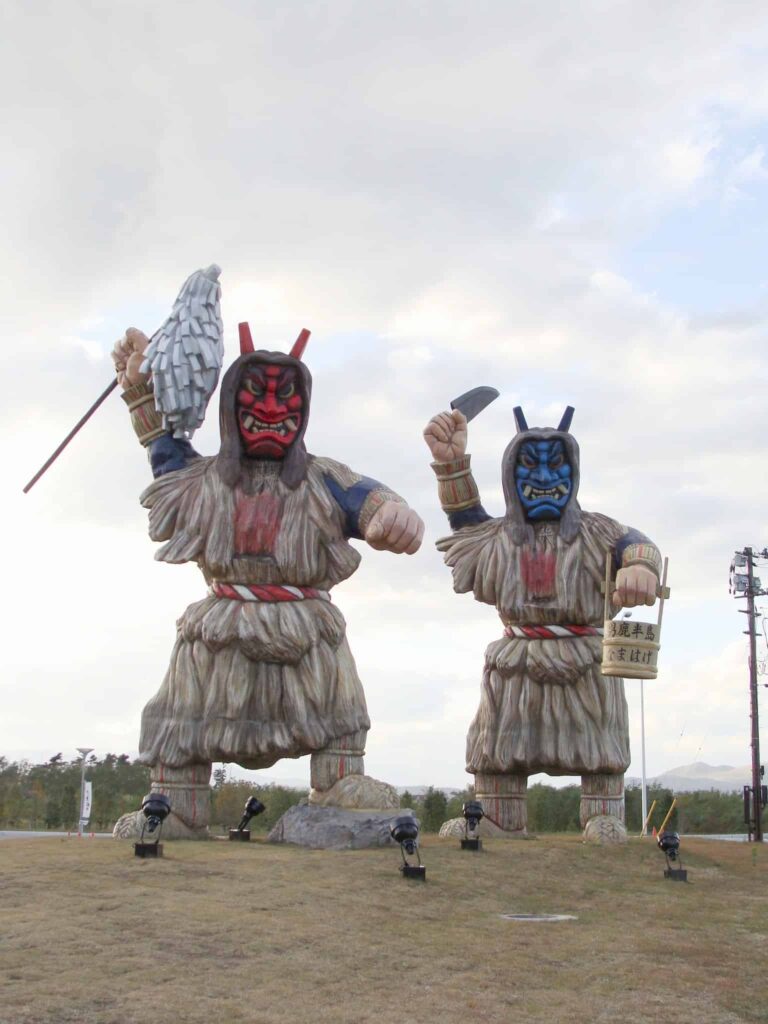
In Akita Prefecture, there is a custom of erecting a straw-bodied, wooden-faced doll called “Kashima-sama” at the entrance of villages, with some reaching heights of up to 4 meters. Although the appearances of Kashima-sama and Namahage are similar, there is no mention of religious significance in the installation of Namahage statues like with Kashima-sama, and their locations are not limited to the entrance of settlements.
In recent years, there has been a trend of installing a pair of red and blue Namahage statues, but it is unclear whether this red and blue pair is a standard tradition in the dozens of villages that have inherited the tradition.
| Location | Body Length/Height | Year of installation |
|---|---|---|
| Oga General Tourist Information Center | 49 feet 39 feet | 2007 |
| Monzen District | 33 feet | |
| Oga Onsen | ||
| JR Oga Station | 2012 | |
| Namahage Bridge | 1997 |
Related artifacts
Items using Namahage
- Air Self-Defense Force Akita Rescue Team Unit Mark
- Emblem of Blaublitz Akita
- On January 18, 2010, a new emblem was announced, featuring a diagram of Namahage placed in the center of the emblem.
- This item contains characters (Unicode 6.0 emoticons) that cannot be displayed on some computers or viewing software.
- Unicode characters
- On October 11, 2010, as part of Unicode 6.0.0, the emoji for “JAPANESE OGRE” (U+1F479), representing Namahage, was registered.
Items inspired by Namahage
- Super God Nega
- A character from Akita Prefecture inspired by Namahage. The creator is a former professional wrestler residing in Nikaho City. The theme song is sung by Ichiro Mizuki. His vehicles include a combine harvester with two rows of teeth and a hatahata-shaped motorcycle.
- Namy Hagie
- The mascot of the Akita World Games 2001 held in 2001. After the event, it was transferred to the Akita Shinkin Bank and used as a mascot for the bank’s distribution materials.
- Oga Namahageez
- A three-member female local idol unit from Akita Prefecture that appeared in the anime “Wake Up, Girls!”. All three members wear costumes resembling a “Jijinamahage” with a demon-like flushed face.
- Gosha Hagi
- A monster of the Fang Beast species that appears in Monster Hunter Rise. Also known as “Yuki Oni-jū.” It freezes its arms with its cold breath and uses them as weapons like ice knives.
Named Namahage but not actual Namahage
- Akita Namahage Agricultural Cooperative
- After its establishment, a character inspired by Namahage was created, and as a result of the name selection, it became “Onimaru-kun.”
- During the period from May 1985 (Showa 60) to September 2006 (Heisei 18) and from May 2012 (Heisei 24) to March 2015 (Heisei 27), a special edition car called “Namahage,” based on the 1300cc model of the Toyota Corolla, was sold exclusively in Akita Prefecture.
- In episode 38 of “Ultraman A” titled “Resurrection! Father of Ultra,” a “Legendary Monster Namahage” appears.
- In the game and anime “Yo-kai Watch,” there is a character named “Namahage.”
- In the anime “K-On!” during the “Live House!” special, there is a band named “Namaha-ge” listed on the band lineup. The characters cannot be confirmed on screen.
- In the “Shouten” (a Japanese TV program) rakugo (comic storytelling) segment, it often refers to Kaoru Katsura (a Japanese comedian) (along with skeleton, mummy, ghost, and monster).


